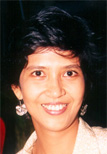 |
|
|
|
 By Anita Devasahayam |
September 21, 1999 Full speed ahead
HOSPITAL Selayang in Selangor became the nation's first paperless and filmless
medical centre when it rolled out portions of IT beginning Aug 2. According to the head of department of
paediatrics Datuk Dr A. Jai Mohan, Selayang Hospital offers arguably the most integrated
total hospital information system anywhere in the world. And Dr Jai Mohan should know as he
is the Health Ministry telehealth steering committee advisor. ``We are already seeing a small
number of patients by appointment only,'' says the well-known telemedicine champion.
The Selayang Hospital is expected to
be fully functional next year. The total health information system
at Selayang integrates many different components. Among them are a clinical information
system, laboratory information system, imaging information system, critical care
information system, personnel management system, resource management and electronic
commerce. Hospital Selayang, which is
currently running as a standalone entity, will be linked to clinics in the vicinity of
Putrajaya including Hospital Putrajaya which will open next year. According to health ministry
director-general Tan Sri Abu Bakar Suleiman, seven new public hospitals will be
computerised in stages. Existing hospitals and rural health clinics will be incrementally
computerised over time. The link will allow these hospitals
and clinics to expand the ability to share medical records seamlessly. At present, healthcare is fragmented
and individual health records reside in islands and investigations are often repeated due
to lack of access to previous records. Adds deputy director-general at the
Ministry of Health Datuk Dr Abdul Aziz Mahmood, the government is currently developing
prototypes at chosen hospitals and rural clinics. Each pilot application is given
clinical algorithms to be worked on where levels of care - primary, secondary, tertiary
and home - are being taken into consideration to determine the workflow process. Aziz adds that the criteria for
consultation is added as well. The tests and experiments will hopefully yield a set of
guidelines to implement telemedicine throughout the country. ``We have to re-engineer our
processes to include the way we work so that IT can be maximised,'' he reiterates. Areas that are being re-engineered
include client-flow, information-flow and staff-flow to reduce redundant processes.
Tele-consultation projects that
include tele-primary care, tele-oncology, tele-nephrology and tele-psychiatry have already
been set up in almost all states. The lifetime health plan project
will be gradually rolled out at Hospital Kuala Lumpur, Hospital Kajang, Hospital Ipoh,
Hospital Seremban and neighbouring health clinics. This, says Dr Jai Mohan, will
increase seamless access to health records and ultimately accords each individual with a
lifetime health record. Periodic examinations through a person's life will enable
education and training, screening, bracketing key categories and intervention to reduce
risk based on care plans, he points out. These care plans will be drawn up by
experts and guidelines will be provided for practitioners to provide quality healthcare to
patients. As telemedicine and the Internet is
associated with speed, it won't be long after its implementation that patients will begin
to expect shorter queues at general hospitals.
Published in In.Tech, Star Publications (M) Bhd. |
|
(C) 2000 Julian Matthews
& Anita Devasahayam. All Rights Reserved. Designed by Gerald Tan Chuang Win of ThriveCast.com |